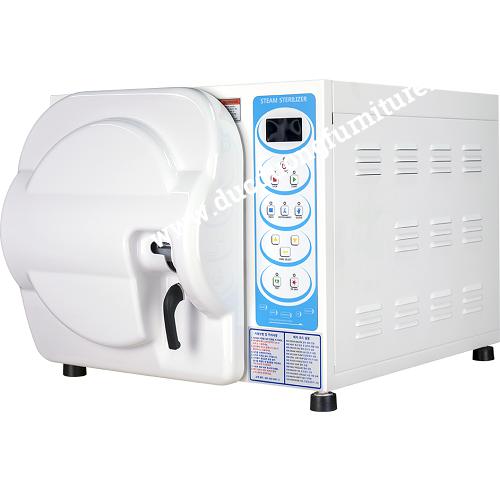What Are Medical Instrument Sterilizers? Effective Sterilization Solutions
I. Introduction to Medical Instrument Sterilizers
Medical instrument sterilizers play a crucial role in ensuring the hygiene and sterilization of medical tools. Especially in the current context, where bacteria are becoming increasingly complex, the use of modern sterilization equipment is essential to protect public health.
II. Types of Medical Instrument Sterilizers
Autoclaves for Medical Instruments

-
Class N Sterilizers:
-
Lowest sterilization effectiveness among the three types.
-
Suitable for sterilizing solid instruments without hollow or intricate parts (e.g., scalpels, scissors, needles, bowls) that have been cleaned and dried before sterilization.
-
Not suitable for sterilizing: Instruments with large lumens (catheters, endoscopes...), instruments with many complex parts (dental instruments, micro-surgical instruments...).
-
Commonly used in dental clinics and small laboratories.
-
Class S Sterilizers:
-
Higher sterilization effectiveness than Class N.
-
Can sterilize solid instruments (e.g., scalpels, scissors, needles, bowls, Petri dishes...) with small lumens or intricate parts (e.g., toothed forceps) that have been cleaned and dried before sterilization.
-
Not suitable for sterilizing: Instruments with large lumens (catheters, endoscopes...), instruments with many complex parts (dental instruments, micro-surgical instruments...).
-
Suitable for medium-sized clinics, hospitals, and laboratories.
-
Class B Sterilizers:
-
Highest sterilization effectiveness among the three types.
-
Can sterilize all types of medical instruments, including solid, hollow, intricate, packaged, and unpackaged instruments.
-
Uses advanced technology to remove air from the sterilization chamber, ensuring optimal sterilization effectiveness.
-
Suitable for large hospitals, high-end laboratories, and medical facilities requiring the sterilization of complex instruments.
Comparison Table for Class S, N, B Medical Instrument Sterilizers
.png)
Additional Notes:
-
Carefully read the manufacturer’s instructions before use.
-
Use the autoclave only to sterilize appropriate instruments.
-
Clean and dry instruments before sterilization.
-
Avoid overcrowding instruments in the sterilization chamber.
-
Regularly check the autoclave’s operation.
-
Perform periodic maintenance according to the manufacturer’s instructions.
III. Principles and Benefits of Medical Instrument Sterilizers
-
Benefits
According to reports from the World Health Organization (WHO), using modern sterilization equipment such as medical instrument sterilizers can reduce the risk of infections in medical facilities by up to 80%. This not only protects patients' health but also extends the lifespan and efficiency of medical instruments.

-
Working Principles of Medical Autoclaves
Medical autoclaves are manufactured with various features, but their basic principles involve three main stages:
AIR REMOVAL > HEATING > STERILIZATION > COOLING
-
Air Removal:
-
Removes all cold air inside the autoclave because air is a poor heat conductor, causing uneven temperature distribution inside the autoclave.
-
Medical autoclaves usually remove air using a vacuum (Prevacuum).
-
Medical autoclaves typically introduce steam through a single pathway, which diffuses evenly due to the pressure difference inside the autoclave.
-
Heating:
-
During this stage, the temperature inside the autoclave is gradually increased to the required sterilization level. This process ensures that all bacteria, viruses, and harmful microorganisms are completely eradicated, ensuring the safety of medical instruments.
-
The autoclave starts heating from room temperature up to the sterilization temperature, typically 121°C.
-
Cooling:
-
In medical autoclaves, this stage is also known as drying. The autoclave cools simply by venting to reduce the pressure and temperature inside the chamber or using a vacuum to dry the instruments.
Contact Us: Click Here
IV. How to Choose the Right Medical Instrument Sterilizer
When selecting a medical instrument sterilizer, consider the following factors:
-
Capacity: Suitable for the scale and usage needs.
-
Sterilization Technology: Choose modern technology to ensure the highest sterilization effectiveness.
-
Brand: Opt for reputable brands like SJ CLAVE - Korea, STERIS, Dabi Alante – Brazil...
V. Instructions for Using Medical Instrument Sterilizers
Basic Steps for Using the Autoclave:
-
Check the Medical Instruments: Ensure the instruments are clean before sterilization.
-
Arrange Instruments in the Autoclave: Place the instruments without overlapping to allow steam to contact all surfaces.
-
Select the Sterilization Mode: Choose the appropriate mode for the type of instruments to be sterilized.
-
Start the Autoclave: Begin the sterilization process and monitor the autoclave.
Important Notes:
-
Carefully read the user manual: Understand the process and functions of the autoclave.
-
Regular Maintenance: Perform periodic maintenance and checks to ensure effective operation.
VI. Price of Medical Instrument Sterilizers
The price of medical instrument sterilizers depends on capacity, technology, and brand. Prices can vary based on the features and specific needs of each medical facility.
VII. Conclusion
Investing in quality medical instrument sterilizers not only ensures patient and staff safety but also enhances the efficiency and usage lifespan of medical instruments. Explore reputable products from brands like SJ CLAVE - Korea, STERIS, Dabi Alante – Brazil, to ensure optimal sterilization quality for your medical facility.
VIII. Frequently Asked Questions (FAQ)
-
How do medical instrument sterilizers work?
-
Medical instrument sterilizers use hot steam under high pressure to kill bacteria and viruses on the surface of instruments.
-
How to choose the right sterilizer?
-
Consider factors such as capacity, technology, brand, and the specific needs of your medical facility.
-
What can medical instrument sterilizers sterilize?
-
They can sterilize most metal medical instruments, heat-resistant plastics, and some specialized fabrics.
-
What should be noted when using medical instrument sterilizers?
-
Read the user manual carefully, ensure instruments are clean before sterilization, and perform regular maintenance for effective sterilization.
IX. Where to Buy Medical Sterilizers?
DUC DUONG TECHNICAL SCIENTIFIC CO., LTD
With years of experience, Duc Duong has established its brand and reputation in providing laboratory furniture and equipment, having carried out many new projects for laboratories, microbiology research rooms, molecular biology, tissue culture, biosafety diagnosis, environmental, food, pharmaceuticals, and aquaculture.
Contact us for immediate consultation: Contact
Or reach us via the hotline below:
Address: 1014/67 Tân Kỳ Tân Quý, Bình Hưng Hòa, Bình Tân, HCM
Tel: (028) 3762 8042 - 3762 8043 - 3750 8514 - 3750 8793
Fax: 028 37628043
Email: ducduong@ducduongco.com
Website: www.ducduongco.com




